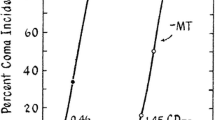Abstract
The effects of cytotoxic substances such as ammonia, bile acids and endotoxin, all of which increase in the circulating blood during fulminant hepatic failure (FHF), on the blood-brain barrier (BBB) permeability and development of brain edema were examined in the rats. Direct intracarotid injection of various bile acids resulted in the staining of the cerebral hemisphere with Evans blue as well as the increase of brain water contents. Elevation of ammonia was also observed in the cerebral hemisphere where the reversible opening of the BBB was induced by deoxycholate under hyperammonemic conditions. To see the synergistic significance of cytotoxic substances (ammonia, bile acid and endotoxin) under the more physiological condition as FHF, they were simultaneously injected into a peripheral vein. Brain uptake index of 14C-inulin and brain water content increased, and electron micrographs showed the swollen astrocytic foot processes surrounded brain capillary, but not opening of tight junction, the same as an animal model of fulminant hepatic failure. The results suggest that ammonia, bile acids and endotoxin might have a possible synergistic role in the pathogenesis of the brain edema, mainly cytotoxic, and vasogenic due to acceleration of vesicular transport, in FHF.
Similar content being viewed by others
References
Folbergrova, J., Passonneau, J.V., Lowry, O.H., Schulz, D.W. (1969). Glycogen, ammonia and related metabolites in the brain during seizures evoked by methioninc sulphoximine.J Neurochem. 16: 191–203.
Fujiwara M. (1986). Role of ammonia in pathogenesis of brain edema.Acta Med. Okayama 40: 313–320.
Gazzard, B.G., Portmann, B., Murray-Lyon, I.M., Williams, R. (1975). Causes of death in fulminant hepatic failure and relationship to quantitative histological assessments of parenchymal damage.Q.J. Med. 44: 615–626.
Hanid, M.A., Davies, M., Mellon, P.J., Silk, D.B., Strunin, L., McCabe, J.J., Williams, R. (1980). Clinical monitoring of intracranial pressure in fulminant hepatic failure.Gut 21: 866–869.
Horowitz, M.E., Schafer, D.F., Molnar, P., Jones, E.A., Blasberg, R.G., Patlak, C.S., Waggoner, J., Fenstermacher, J.D. (1983). Increased blood-brain transfer in a rabbit model of acute liver failure.Gastroenterology 84: 1003–1011.
Livingstone, A.S., Potvin, M., Goresky, C.A., Finlayson, M.H., Hinchey, E.J. (1977). Changes in the blood-brain barrier in hepatic coma after hepatectomy in the rat.Gastroenterology 73: 697–704.
Lo, W.D., Ennis, S.R., Goldstein, G.W., McNeely, D.L., Betz, L. (1987). The effect of galactosamine-induced hepatic failure upon blood-brain barrier permeability.Hepatology 7: 452–456.
Lockwood, A.H., Bolomey, L., Napoleon, F. (1984). Blood-brain barrier to ammonia in humans.J. Cereb. Blood Flow Metabol. 4: 516–522.
Oldendorf, W.H. (1970). Measurement of brain uptake of radiolabeled substances using a tritiated water internal standard.Brain Res. 24: 372–376
Pardridge, W.M., Connor, J.D., Crawford, L.L. (1975). Permeability changes in the blood-brain barrier: Causes and consequences.CRC Crit. Rev., Toxic. 3. 159–199.
Rapoport, S.I., Hori, M., Klatzo, I. (1972). Testing of a hypothesis for osmotic opening of the blood-brain barrier.Am. J. Physiol. 223: 323–331.
Sarna, G.S., Bradbury, M.W.B., Cavanagh, J. (1977). Permeability of the blood-brain barrier after portcaval anastomosis in the ratBrain Res. 138: 550–555.
Schenker, S., McCandless, D.W., Brophy, E. (1967). Studies of intracerebral toxicity of ammonia.J. Clin. Invest. 46: 838–848.
Shiota, T. (1984). Accelerated leucine decarboxylation in the rat brain in relation to increased blood ammonia levels during acute hepatic failure.Acta Med. Okayama 38: 219–225.
Spigelman, M.K., Zappulla, R.A., Malis, L.I., Holland, J.F., Goldsmith, S.J., Goldberg, J.D. (1983). Intracarotid dehydrocholate infusion: A new method for prolonged reversible blood-brain barrier disruption.Neurosurgery 12: 606–612.
Tanigawa, K., Rikitake, K., Akashi, T. (1985). Intracranial pressure.Progress in Research in Liver Disease 2:13–21.
Traber, P.G., Canto, M.D., Ganger, D.R., Blei, A.T. (1987). Electron microscopic evaluation of brain edema in rabbits with galactosamine-induced fulminant hepatic failure: Ultrastructure and integrity of the blood-brain barrier.Hepatology 7:1272–1277.
Zaki, A.E.O., Wardle, E.N., Canalese, J., Ede, R. J., Williams, R. (1983). Potential toxins of acute liver failure and their effects on blood-brain barrier permeability.Experientia 39: 988–991.
Zaki, A.E.O., Ede, R.J., Davis, M., Williams, R. (1984). Experimental studies of blood-brain barrier permeability in acute hepatic failure.Hepatology 4: 359–363.
Zieve, L., Doizaki, W.M., Zieve, F.J. (1974). Synergism between mercaptans and ammonia or fatty acids in the production of coma: a possible role for mercaptans in the pathogenesis of hepatic coma.J. Lab. Clin. Med. 83:16–28.
Zimmermann, V., Hossmann, K.A. (1975). Resuscitation of the monkey brain after one hour's complete ischemia. II. brain water and electrolytes.Brain Res. 85: 1–11.
Author information
Authors and Affiliations
Rights and permissions
About this article
Cite this article
Tominaga, S., Watanabe, A. & Tsuji, T. Synergistic effect of bile acid, endotoxin, and ammonia on brain edema. Metabolic Brain Disease 6, 93–105 (1991). https://doi.org/10.1007/BF00999907
Received:
Accepted:
Issue Date:
DOI: https://doi.org/10.1007/BF00999907




